There wouldn’t be film without film lighting. Lighting is as crucial to cinematic storytelling as a script and a subject, and filmmakers have experimented with different lumination techniques for as long as the medium has existed. In this article, we’ll walk you through everything you need to know about lighting for film, from terminology to techniques. Ready to dive into over a hundred years worth of lighting knowledge?
Types of Lighting in Film
Types Of Light
Not all types of film lighting are created equally. Light comes in a wide variety of forms, packages and sources. So before you start flipping switches on set, it’s important to know all the options you can work with.
All types of film lighting fall under one of two categories: natural and artificial. Natural light is — you guessed it — light which occurs naturally. This can be illumination coming from the sun, moon, fire, or firefly.

The Revenant makes heavy use of natural light • Film lighting
Artificial light, on the other hand, is man-made. Streetlights, neon lights, flashlights, LED panels — these are all artificial. The lights that a film crew lugs onto set and boots up several generators to power? Those are artificial too.
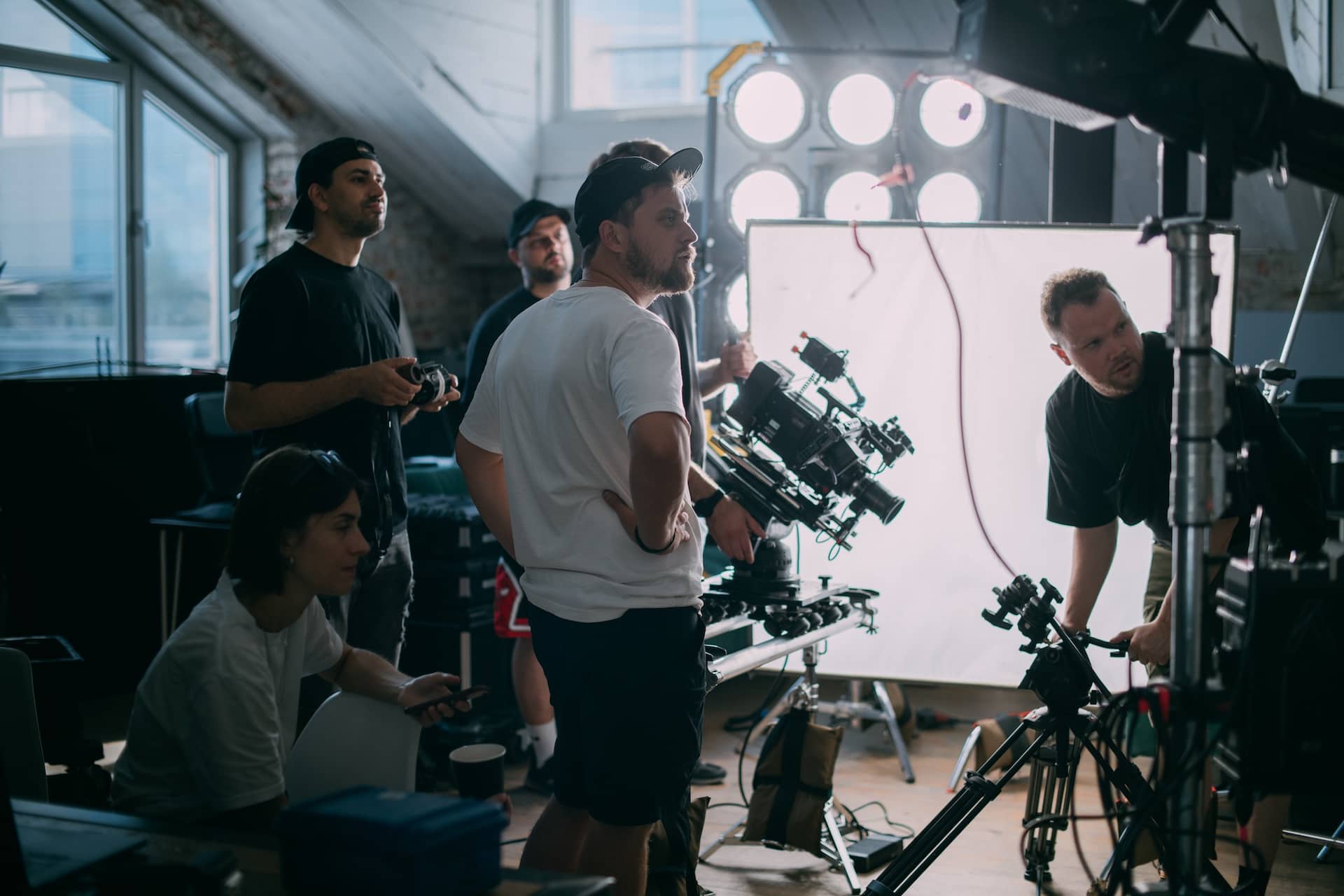
Movie set film lighting • Filmmaking lighting
But artificial and natural aren’t the only categories which lights can be divided into. For example, there’s also ambient light, which refers to any light on set which the crew didn’t bring.
Ambient light can be either artificial or natural. If you’re shooting in a bar, ambient light may be coming from a buzzing “open” sign. If you’re shooting on the side of the road, passing cars’ headlights would be ambient. Of course, if you’re shooting outside during the day, you’re going to have to deal with the most powerful ambient light of all: the sun.

Ambient fluorescent lights in Chungking Express • Film lighting
Ambient lights can also occasionally fall into another category if they’re used as they are in the above image. Any light source that appears in the frame of a shot is referred to as practical lighting.
But practical lighting in movies doesn’t have to be ambient– it could also be placed in the shot by a gaffer.
GAFFER DEFINITION
WHAT IS A GAFFER?
A gaffer is the head lighting electrician on set. As such, she runs the entire electrical department of the crew, and helps the director of photography achieve the film lighting desired for each shot.
Practical lighting for film is often closely related to motivated lighting – yes, another category, but this one’s slightly different. Motivated lighting in film refers to a lighting approach rather than a source.
Motivated lighting is filmmaking lighting — wait for it — which has motivation. In other words, it is lighting that has a logical reason for appearing the way it does in a shot.
It’s easier to explain motivated lighting with an example. Take a look at this shot from George Miller’s Three Thousand Years Of Longing.
Three Thousand Years Of Longing • Types of lighting in film
There’s a lot of lighting going on here, with a variety of sources and textures. There’s two prominently featured practical lights, the lamps which are on either side of Alithea.
The right lamp provides some edge light on her back, and the left provides a diffused red glow on her face – or so it seems. It’s likely that the red lamp, while providing motivation for a warm light on Alithea’s face, is not actually the light providing it.
That’s probably a much less aesthetically pleasing light off frame.
Then, of course, there’s the harsh blue spotlight shining down on the object of Alithea’s attention. Like the red light on her face, this light is likely created by a strong film light just off frame. But that’s not how we view the light in the scene– we can safely assume that it is coming from the sun through a window in the bizarre. So this light, too, is motivated.
Check out our video focusing on the master of practical lighting for film, Roger Deakins, below.
Deakins talks practicals • Subscribe on YouTube
As Deakins illustrates, knowing all of the types of lights at your disposal is key in creating a shot filled with dynamic lighting.
Before we go on, below is a PDF of a film lighting cheatsheet. Just click the image to download.
Cinematic Lighting Cheatsheet PDF Download
Click to view and download Cinematic Lighting Cheatsheet PDF below.
Click above to download Cinematic Lighting Cheatsheet PDF
Different Types of Lighting in Film
Lighting Metrics
While film lighting is certainly an artform, it also involves a certain level of scientific knowledge. Many cinematographers and gaffers know their fair share of physics, and as we’ll explain in this section, it’s for good reason.
There are two main types of lighting measurements which cinematographers are concerned with: strength and temperature.
Strength
A light source’s strength is measured in lumens. But lumens don’t always tell the whole story. DP’s and gaffers also need to be concerned with incidental light, which refers to how much light actually reaches a subject. Incidental light is measured in lux or foot candles.

Lumens chart • Types of lighting in film
But wait, there’s more! Understandably, a cinematographer needs to know how much of that incidental light is going to reach the camera. That light, the light which shows up on your viewfinder, is referred to as reflective light – it’s light which has been reflected off an object and onto your cam’s sensor.
The amount of light which reaches the camera is dependent on two main variables (math incoming): the strength of the light source and the source’s distance from the subject.
Imagine you’re trekking through a dark wood like some character out of a Brothers Grimm fable, and you need a light in order to see. A kindly fairy godmother presents you with two options: a small, flickering candle or a heavy-duty flashlight. Presumably, you’d take the flashlight, and that’s because the flashlight is stronger – it has more lumens.
But as you’re trekking through this dark wood, you realize that you’re still pretty frightened because your flashlight’s light only reaches so far ahead of you. That’s where light’s distance comes into play: the farther a subject is from a light, the less that light will show up, the less incidental light there will be.
This phenomenon is called light falloff. In order to calculate just how much a light can be expected to fall off, we use an equation called the Inverse Square Law. The equation is as follows:
Intensity of Light = 1 / Distance²
The farther you get from light, the more diffuse it gets, as you can see in this illustration:

Inverse Square Law • Lighting for film
Temperature
A light source’s temperature is just as important as its strength, because while strength dictates brightness, temperature dictates color.
Color temperature is measured in Kelvins, and the more Kelvins a light has, the more blue it is. Daylight sits at around 5600 Kelvin, while most tungsten lights are about 3200 Kelvin.

Handy Color Temperature Chart • Lighting in movies
If you’ve filmed inside near a window before, you’ve probably noticed this color discrepancy. If you split the difference when white balancing, the sun (or moonlight) coming through the window probably reads as blue, and the artificial light inside reads as orange.
Stanley Kubrick makes heavy use of this contrast in Eyes Wide Shut.

Eyes Wide Shut • Lighting for filming
Notice that the light coming through the window is a deep blue, while the light from the hallway is a warm orange. It’s likely, however, that cinematographer Larry Smith were not using actual moonlight through the window.
And this is where knowledge of color temperature can really come in handy.
The Eyes Wide Shut crew knew that to mimic moonlight, they could simply use gels on the lights to achieve a color temperature that was far bluer than the light inside.
Check out our video on color temperature for lighting in filming.
Color temperature • Subscribe on YouTube
Once you have a firm grasp on light strength and temperature, your lighting in filming can become far more deliberate. Achieving the look you’ve dreamt up in your head won’t be a guessing game.
Related Posts
Lighting Terms for Film
Film Lighting Terms
Believe it or not, we’ve only just scratched the surface of lighting terms for film that you’re likely to hear on set. Let’s do a quick rundown of some more terms so that your head isn’t left spinning when you happen to be standing next to the cinematographer.
One of the most basic, and important, terms when it comes to lighting for film is exposure. Exposure refers to the amount of light that reaches a camera’s film sensor (you’ll recall we referred to that light as reflective).
An image which is overexposed is getting too much light, so that certain elements of the shot are washed out.

Deliberate overexposure in LOTR • Types of lighting in film
An underexposed frame is one which is losing data on the other end– it’s simply too dark. There are a variety of ways to solve overexposure or underexposure beyond adjusting lights. A camera operator can adjust the aperture, shutter speed, or ISO to better suit the lighting set up.
The aperture determines how much light will enter a lens and hit the camera’s sensor. An aperture’s size is measured in F-stops.
Two other terms that are commonly used when describing a lighting approach are high key and low key. These approaches are defined by their contrast ratio, the contrast between light and shadow.
High key lighting has a low contrast ratio. This means that the difference between the darkest areas in the frame and the brightest is relatively small.

High key lighting in Her • Lighting on film set
Low key lighting, unsurprisingly, is the opposite. Its highlights are bright and shadows are dark. This lighting approach is most iconically used in noirs, but is popular all over the genre spectrum.
Chiaroscuro also refers to this type of low key lighting, boasting deep, dark shadows that heighten the feeling of ominous mystery.

Chiaroscuro lighting in Touch of Evil • Why is lighting important in film?
High and low key lighting are made up of hard light and soft light. Hard light refers to harsh, directional lighting which creates pronounced, dark shadows. Soft light, on the other hand, is diffused, meaning the contrast ratio it creates is often much lower.
Because of this, high key lighting often employs soft light, and low key lighting uses hard light, as you can see in the above frames.
There’s also terminology which refers to a light’s location. Magic hour, otherwise referred to as golden hour, is when the sun is positioned low in the sky, creating a soft, warm light which looks great on camera.
Smart side and dumb side refer to a light’s position in relation to the camera. The dumb side, also labeled the broad side, is when a light is pointed at the side of a subject which is facing the camera, as you can see in this shot from When Harry Met Sally:

When Harry Met Sally • Types of lighting in film
Dumb side lighting is often used in feel-good settings like this. We can see everything, and are therefore more at ease as an audience.
Smart side lighting, also referred to as short side, is when a light is pointed at the side of a subject which is not facing the camera. The effect is far more dramatic and, in certain settings, scary. In A Nightmare On Elm Street, Wes Craven mostly lights Freddy Krueger’s smart side.

Nightmare on Elm Street • Film lighting
He’s therefore little more than a silhouette, putting the viewer on edge. Smart side movie lighting can also result in a lens flare, which is when a light hits the camera lens. J.J. Abrams is notorious for this effect.

Star Trek • Types of lighting in film
Lights within the frame that are out of focus can also create bokeh, if you have a shallow enough focus. The effect is dreamlike, placing the subject far from the rest of the world.

Grand Budapest Hotel • Movie lighting
So now you’ve got a small dictionary’s worth of terms to rattle off next time you’re on set. But what good are these terms if you don’t have the gear to achieve them?
Related Posts
Type of Lighting in Film
Film Lighting Gear
If you’ve ever been on a professional film set, you know that there’s a lot of equipment, and a huge chunk of the truckloads of equipment have to do with lighting. So with that in mind, we probably won’t be able to get into every single piece of movie lighting gear you might encounter, but we can look at a few of the most common pieces of equipment you should be familiar with.
As we mentioned before, lighting for cinema comes in a variety of shapes and sizes, and so you’ll run into a lot of different types of lights on set.
Tungsten lights are powerful sources which emit a warm color temperature. HMI lights are even more powerful, and emit a slightly cooler temperature, which means they are often used to replicate daylight.
Fluorescent lights are less powerful, and give off a soft, cool light. Kino Flos are banks of tube lights which have adjustable color temperatures. LED lights offer even more control over color and strength, even though they usually won’t achieve the level of brightness an HMI can.
Dials on lights aren’t the only way to manipulate a source’s color. You can also use a gel, which is a translucent thin sheet of plastic that comes in a variety of colors.
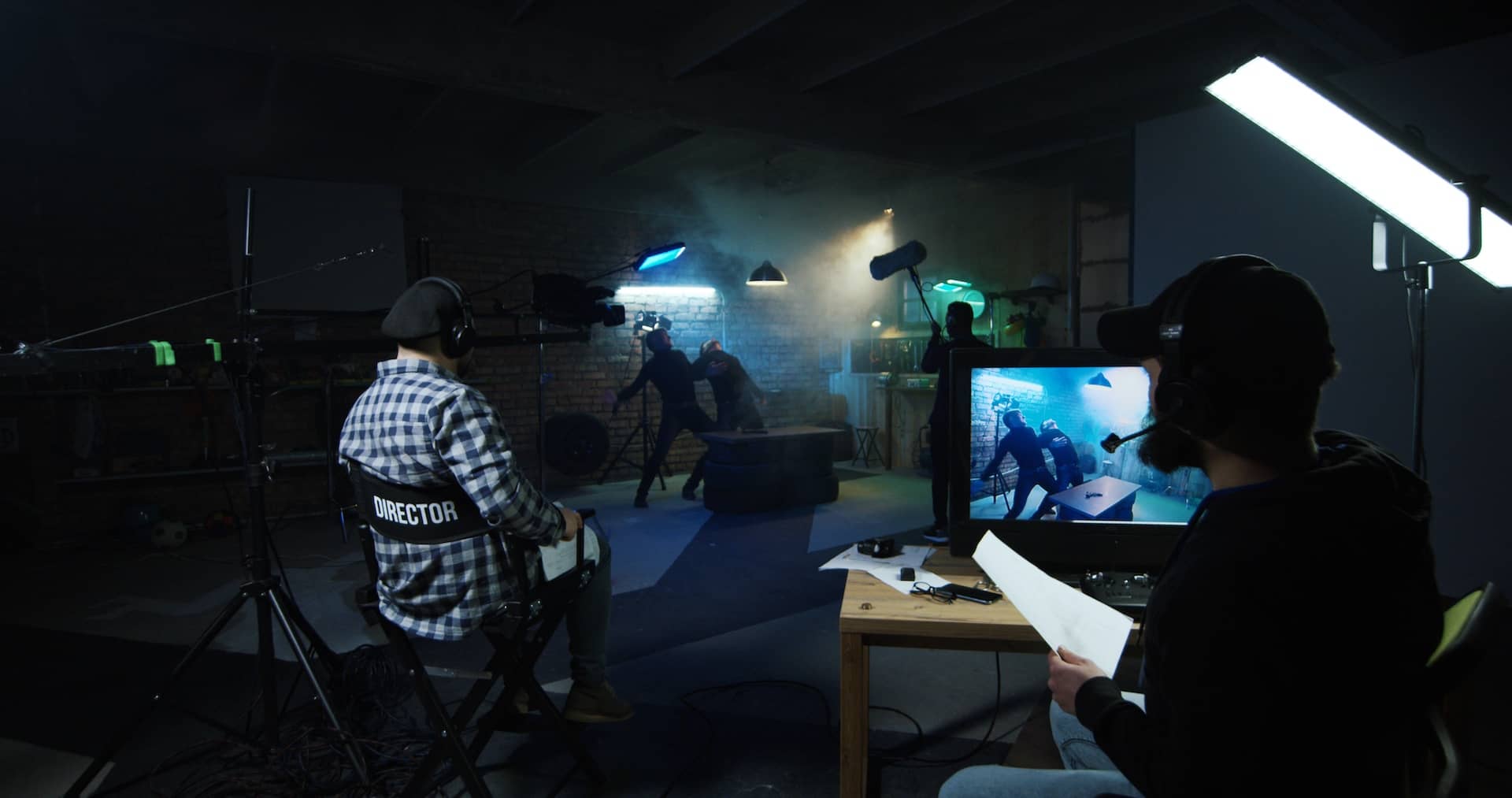
Action fight scene lighting • Lighting for filming
You can also adjust how hard a light is with a variety of diffusers. The more diffused a light source is, the softer the light it emits.
Soft boxes put a white cloth in front of a light, and diffusion paper has a similar effect just with – you guessed it — paper. Sometimes a silk is used for very large light sources. Roger Deakins is a big proponent of this approach.
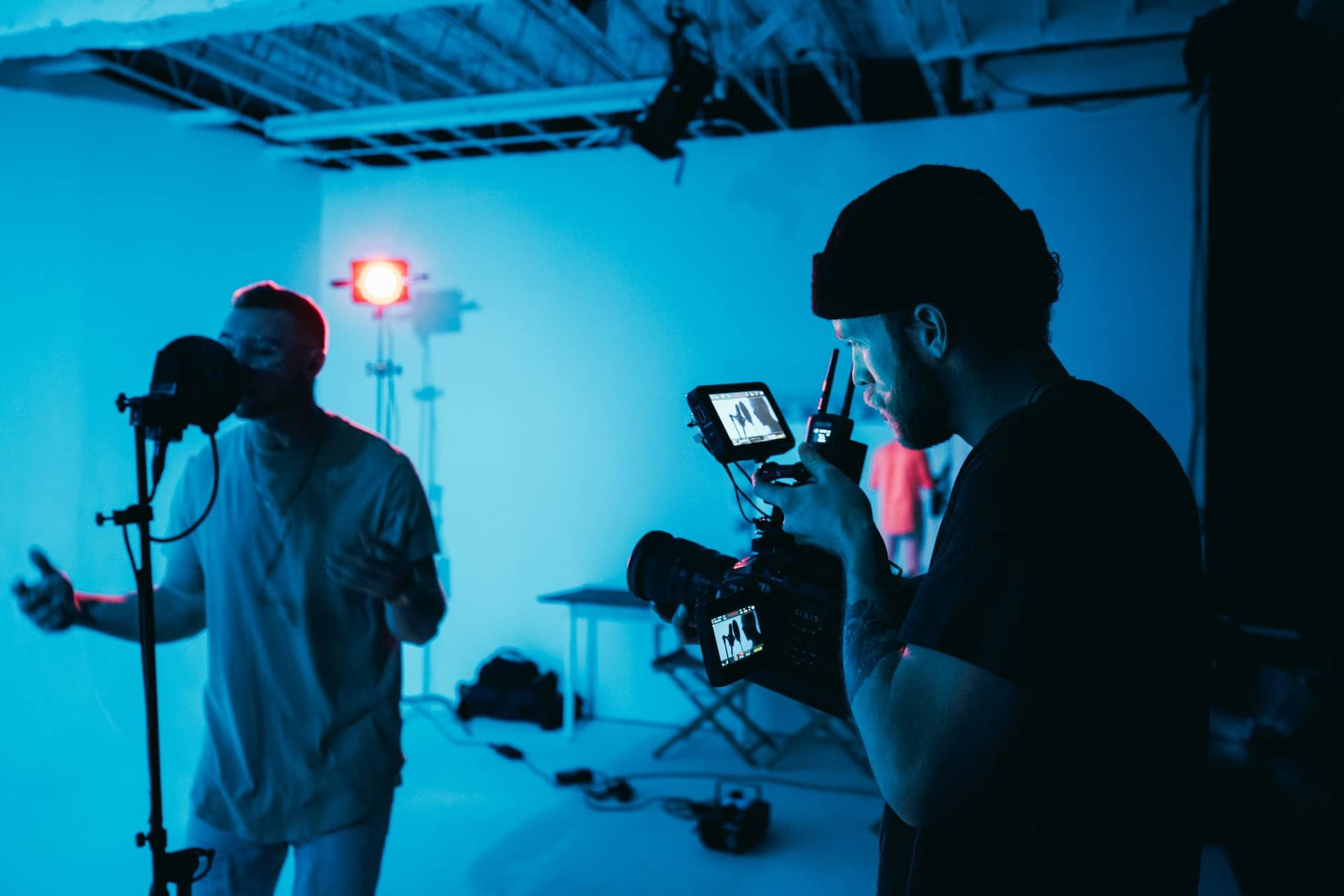
Music video production set with backlighting • Movie lighting
There’s also natural diffusers as well, like fog, smoke, and the sun’s biggest diffuser, clouds.
Reflectors can also help with diffusion, as you can see above, while also redirecting light. Beadboards are styrofoam boards that have rough surfaces which break up light in a more uneven manner, while foamcore is a flatter bounce because its surface is consistent.
We can also adjust a light source's strength by using neutral density gels, which, like other gels, can be placed over a light.
Flags totally block out light, as they are completely opaque boards. Barn doors are also opaque, but attached to lights themselves to adjust their direction and shape. Egg crates do a similar job.

The egg crate • Types of lighting in film
Cookies, short for cucoloris, add texture to a light. They’re boards with patterns cut into them.
Of course, a light can’t just stand on its own (usually), so you’re going to need light stands or C-stands, which are multi-purpose stands that can hold lights, flags, reflectors, and more.
And remember all the light measurements we were talking about in our previous section? Well, to take those measurements you need a light meter, which can tell you how much incidental lighting there is in a given area.
We could go on (and on), but for now we’ll stop here. If you’ve got access to just what we mentioned above, you’ll have more than enough to create the illumination you need on set.
Happy lighting.
Related Posts
Up Next
Portrait Lighting Setups
Now that you’ve got the terms, you’ve got the gear, and you’ve got the will, check out our comprehensive guide to portrait lighting. You can use your new knowledge of types of lighting in film to fantastic ends.
Up Next: Portrait Lighting →
Showcase your vision with elegant shot lists and storyboards.
Create robust and customizable shot lists. Upload images to make storyboards and slideshows.
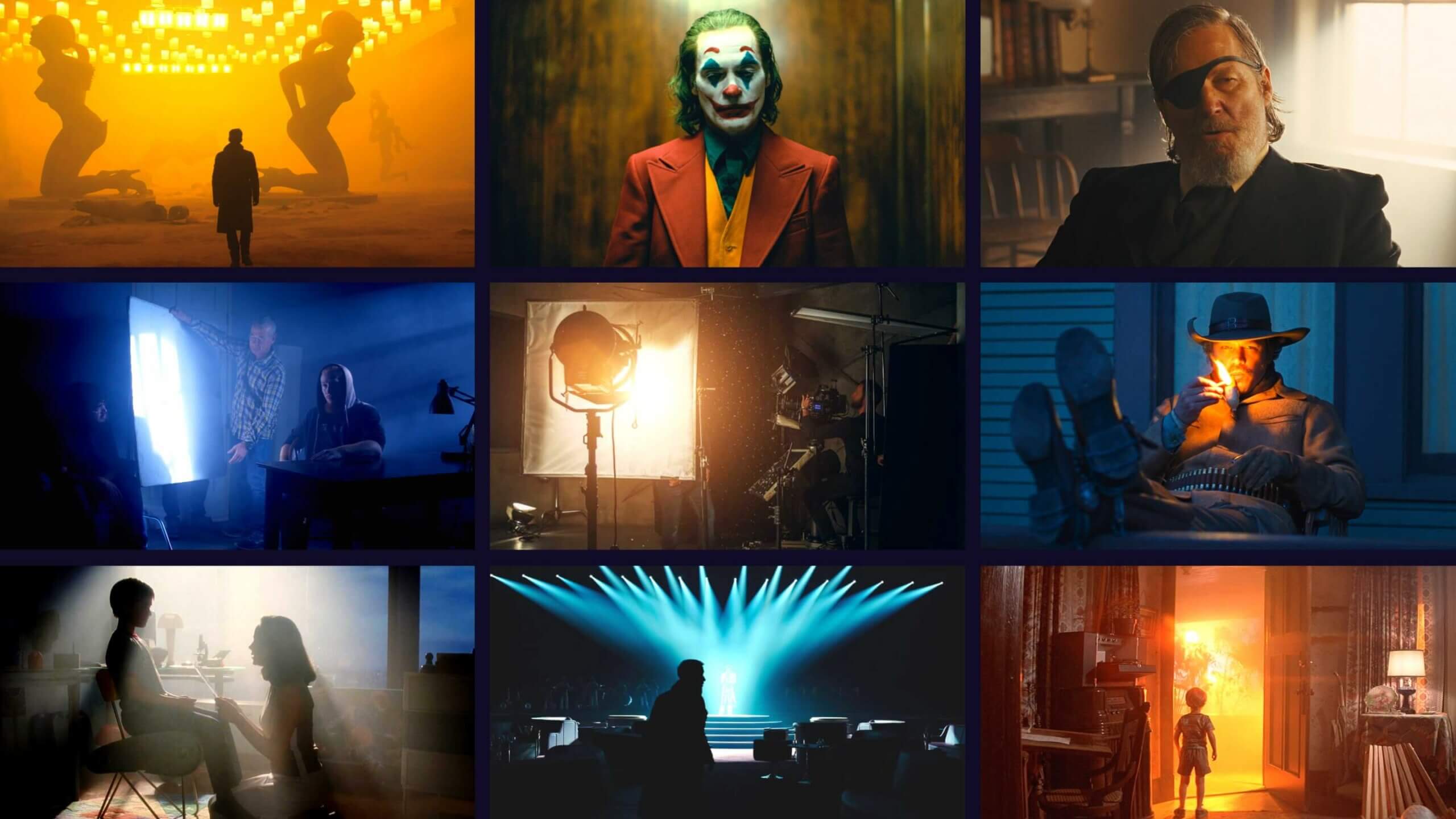
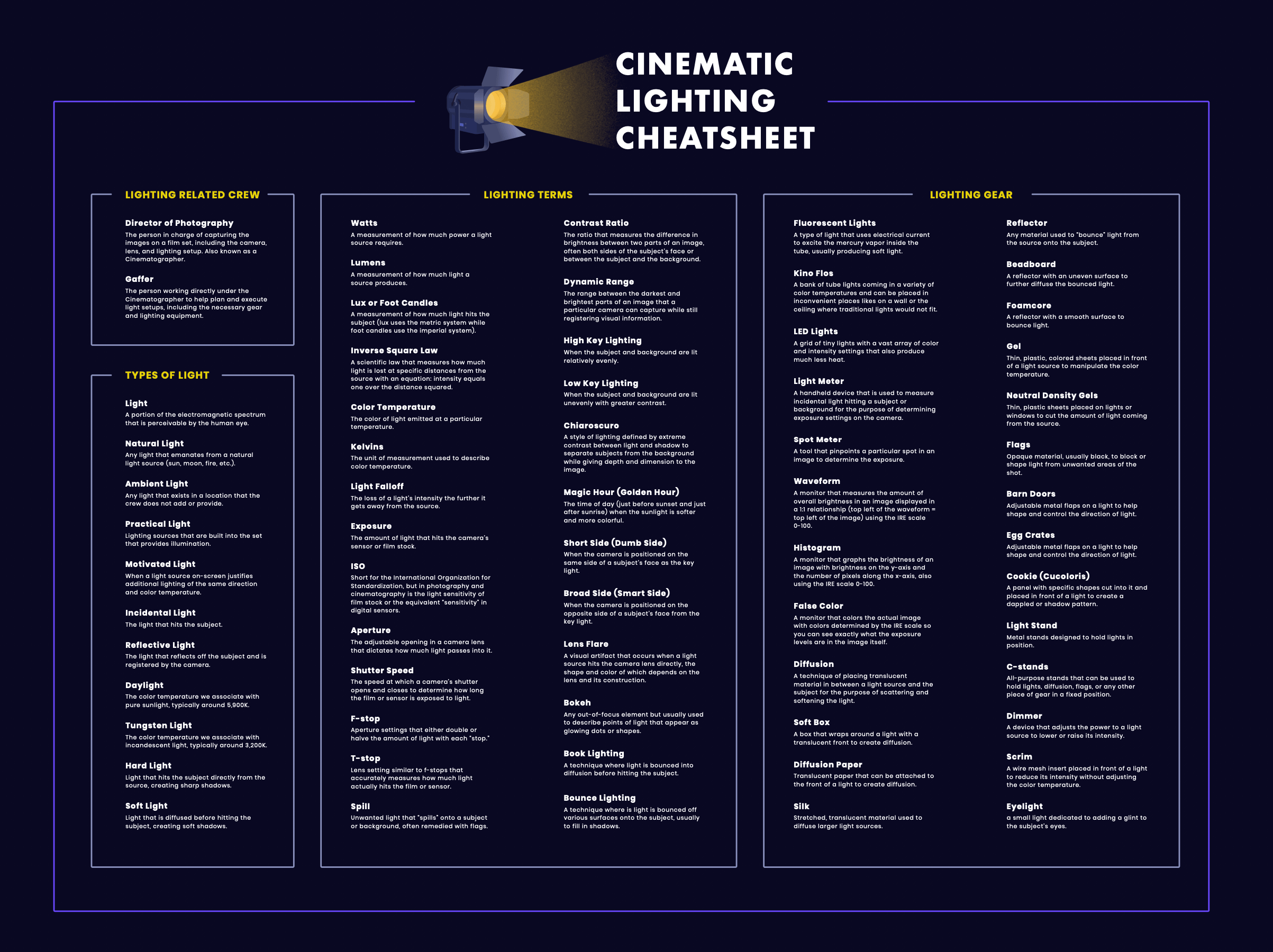
Good stuff
Pls I do I join and follow this. I really am loving the breakdown. Pls any info on this.
Amazing stuff! Thanks!
Helpful
I really like this channel, This is help me for my work and my hobby.